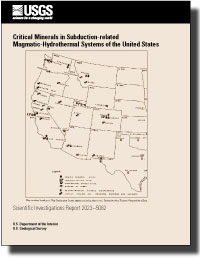Critical Minerals in Subduction-related Magmatic-Hydrothermal Systems of the United States
Links
- Document: Report (6 MB pdf) , HTML , XML
- Download citation as: RIS | Dublin Core
Abstract
During the World War and Cold War eras (1910s–1990s), domestic consumption of numerous mineral commodities relied increasingly on imported supplies. Consumption reliance has since expanded to include 50 “critical minerals” (elements and mineral commodities) that are mostly to entirely imported and subject to curtailment by suppliers or supply chain disruption. New domestic supplies of critical minerals are being pursued by mining companies and by several federal departments and agencies. Information on domestic deposits and resources of critical minerals is being compiled by the U.S. Geological Survey Mineral Resources Program, which has organized investigations by mineral system, deposit type, and commodity.
Production, reserves, resources, and inventories of 21 critical minerals in domestic magmatic-hydrothermal deposits related to subduction-generated magmatism, and in tailings, slag, slimes, and electrolyte from copper concentrators, smelters, and refineries that processed some deposits, are largely restricted to Western States and Alaska. The critical mineral commodities Al, Sb, As, Bi, Co, fluorite, Ga, Ge, In, Mn, Ni, Nb, Pd, Pt, potash, Re, Ta, Te, Sn, W, and V are variably concentrated in porphyry/skarn copper-(molybdenum), skarn-replacement-vein (S-R-V) tungsten, polymetallic sulfide S-R-V intermediate sulfidation (IS), high-sulfidation gold-silver, low-sulfidation gold-silver, and lithocap alunite deposit types. These deposit types occur in porphyry copper-molybdenum-gold, alkalic porphyry, porphyry tin (granite related), and reduced intrusion-related mineral systems.
Production, reserves, and resources of Co, Ni, Nb, Pd, Pt, Ta, Sn, and V in subduction-related deposits in Western States are insignificant to small, mostly equivalent to months to a few years of recent annual domestic consumption (2016–2020). Significant inventories, equivalent to 2 or more years of consumption of aluminum, antimony, potash, and tungsten in unmined S-R-V tungsten, polymetallic sulfide S-R-V-IS, and lithocap alunite deposits vary from approximately 2 to 8 years. Several decades of consumption of arsenic, bismuth, fluorite, gallium, germanium, and indium exist in some polymetallic sulfide S-R-V-IS and lithocap alunite deposit types.
Based on concentrations of critical minerals in reserves, resources, drill holes, and deposit domains (ore types), and in captive refinery records, the largest domestic inventories of Sb, As, Bi, Re, and Te, and possibly Ga, Ge, In, Sn, and W, are in porphyry copper-molybdenum (Cu-Mo) deposits in Alaska, Idaho, Utah, and Arizona, and in interim products of processing porphyry Cu-Mo deposit ores for recovery of copper and molybdenum. Concentrations of critical minerals in archival specimens and sample collections, although somewhat biased by collection and conservation decisions and categorization, are broadly proportionate to those in reserves, resources, and drill holes. These concentrations imply significant inventories of some critical minerals in deposits for which production, resources, and refinery records are unavailable or incomplete.
Because of the large masses of ores mined and processed annually (hundreds of millions of metric tons) and in reserves and resources (hundreds of millions of metric tons to billions of metric tons), calculated inventories of critical minerals in porphyry Cu-Mo deposits are equivalent to decades and centuries of recent consumption. However, these inventories should not be considered consumable supplies without reserve definition and development of economically viable mining plans and recovery techniques. An expeditious strategy for elimination or reduction of import reliance is recovery, and improved recovery efficiency, of Sb, As, Bi, Re, and Te, and possibly Ga, Ge, In, Ni, Sn, Ti, and W; during concentration and refining of copper and molybdenum minerals in ores of operating porphyry Cu-Mo mines; and in unmined porphyry Cu-Mo resources. These chalcophile, siderophile, and lithophile critical minerals, often undetectable in ore, are concentrated (hundreds of parts per million to percents) in slimes and electrolyte during copper electrorefining or could be recovered, in part, during sulfide concentration and smelting. Other than rhenium (recovered during molybdenum refining) and tellurium, all have been routinely discarded.
Subsidization (for example, commodity price guarantees, tax credits, recovery technology development), political initiative, and (or) sustained market favorability could support new production of critical mineral commodities from subduction-related magmatic-hydrothermal deposits in Western States. In addition, insufficient domestic refining capacity could relegate the large inventories of critical minerals in porphyry Cu-Mo reserves and resources (for example, Pebble, Alaska; Resolution and Copper World [Rosemont], Arizona) to exportation in concentrates and importation insecurity, fortifying their present status.
Suggested Citation
Vikre, P., John, D., Wintzer, N.E., Koutz, F., Graybeal, F., Dail, C., and Annis, D.C., 2023, Critical minerals in subduction-related magmatic-hydrothermal systems of the United States: U.S. Geological Survey Scientific Investigations Report 2023–5082, 110 p., https://doi.org/10.3133/sir20235082.
ISSN: 2328-0328 (online)
Study Area
Table of Contents
- Abstract
- Introduction
- Brief History of Critical Minerals
- Limitations and Assumptions
- Chapter A. Primary Product and Coproduct Production of Critical Minerals
- Chapter B. Byproduct Production of Critical Minerals
- Chapter C. Inventories, Reserves, and Resources of Critical Minerals in Porphyry Copper-Molybdenum-Gold and Other Mineral Systems
- Chapter D. Critical Minerals in Archival Specimens and Collection Samples
- Conclusions
- References Cited
| Publication type | Report |
|---|---|
| Publication Subtype | USGS Numbered Series |
| Title | Critical minerals in subduction-related magmatic-hydrothermal systems of the United States |
| Series title | Scientific Investigations Report |
| Series number | 2023-5082 |
| DOI | 10.3133/sir20235082 |
| Publication Date | October 05, 2023 |
| Year Published | 2023 |
| Language | English |
| Publisher | U.S. Geological Survey |
| Publisher location | Reston, VA |
| Contributing office(s) | Geology, Minerals, Energy, and Geophysics Science Center, Western Mineral and Environmental Resources Science Center |
| Description | x, 110 p. |
| Country | United States |
| Online Only (Y/N) | Y |


